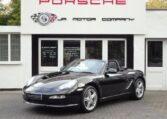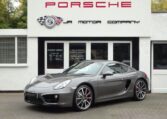PORSCHE (718) BOXSTER 2.0T PDK
Outstanding Boxster 718 2.0T Finished in rare Night Blue complate with a huge specification and only 37000 Miles!£35,995
£34,995
SoldPorsche 718 Boxster 2.0T GTS PDK finished in Night Blue Metallic paint.
This is a huge specification 718 Boxster 2.0T PDK Finished in rare special order Night Blue metallic paint with a huge list of factory fitted options which includes Luxor Beige heated and vented smooth leather 14 way adjustable electric seats with memory,extended leather to inc doors,center console and dashboard,alluminium interior package,heated smooth leather multifunction steering wheel,seat belts in Luxor beige,light design package,black dials,Porsche entry and drive,cruise control,air conditioning,electric folding exterior mirrors,passanger footwell storage net,bi xenon headlamps in black,(PCM4) Porsche communications management online navigation inc bluetooth,connect plus,Apple car play,DAB radio linked with Porsche sound package,park assist front and rear with reverse camera,(PSM) Porsche Stability Management,top tinted windscreen,Porsche overmats,(PVTS) Porsche vehicle tracking system,fully refurbished 19 inch Boxster S alloy wheels with colour crested centers wrapped in Pirelli P Zero N rated tyres and red calipers,(TPMS) tyre pressure monitoring system,rollover bar finished in night blue,wind deflector and flycatchers,model designation 718,sports tailpipes in chrome and a blue hood to complete the package and one outstanding Boxster.This stunning 718 comes complete with a fully documented OPC Porsche plus specialist service record recently completed by ourselves totalling 3 stamps together with all spare keys and handbook pack.A very unique Boxster with Stunning looks,awesome sound and knockout specification!
Contact us anytime to arrange a viewing.
- (PSM) Porsche Stability Management
- 19" Boxster S Alloys
- Air Conditioning
- AUX Interface
- Bi-Xenon Headlights
- Bluetooth® Handset
- Colour Crested Wheel Centers
- Cruise Control
- Extended Leather
- Flycatchers & Wind Deflector
- Heated Seats
- Heated steering wheel
- Multifunction Smooth Leather Steering Wheel
- Park assist front and rear
- PCM4
- PDK
- Porsche Sound Package Plus
- PVTS
- Reverse Camera
- rollover bar finished in bodycolour
- Satellite Navigation
- Sports exhaust tailpipes
- Universal Multimedia Interface
- USB Audio Interface
In the mid-1990s, if you wanted a semi-affordable sports car with a beefy engine, you’d have probably had to buy a TVR. Then, all at once, the BMW Z3, Mercedes-Benz SLK and Porsche Boxster turned up.
Instantly, the Boxster was the most serious sports car of the three. The BMW and Mercedes were boulevardiers by comparison.
Then the Audi TT arrived, immature and underpowered. Thousands of people no longer needed to buy plastic-bodied British sports cars to get their open-topped, many-cylindered fix.
And what a fix. With the Boxster began Porsche’s rediscovering of what mid-engined positioning could do for a car’s handling – a gradual development, discovery and reappraising of customer expectations that has culminated in the Cayman GT4 being better to drive, in many people’s minds, than all but the most extreme – or including the most extreme – Porsche 911s.
That all began in 1996 with the 986-generation Boxster, which arrived in 2.5-litre form and stayed that way until 2000. Then it was upgraded to 2.7 litres and accompanied by a 3.2-litre S model.
As engines got bigger, power outputs rose. The 987-generation car arrived in 2005 and the 981 in 2012, and each time you could have greater swept capacity and more power – up to 3.8 litres and 370bhp in the case of the most recent Boxster Spyder.
It’s the capacity we’re focusing on, because now there’s less. Much less. The new 718 Boxster arrives displacing barely more than half the 3.8 litres of that Spyder.
Whereas once you had six cylinders of naturally aspirated, pure Porsche sound in the Boxster’s middle, now there is a 2.0-litre turbo flat four.
It would have been unthinkable in 1996. But what do we think of it today? And does it dilute the very essence of the roadster’s appeal?

Although top-of-the-line 718s will use six-cylinder engines like their direct forebears, the biggest-selling Boxster, Boxster S, Cayman and Cayman S are now powered by horizontally opposed four-cylinder engines – just like the racing Porsches of the 1960s of the same numerical identity.
The lower-rung Boxster’s engine is a 2.0-litre unit of 296bhp and 280lb ft and the higher-end Boxster S has 2.5 litres with 345bhp and 310lb ft. Both engines have the same 76.4mm cylinder stroke and significantly oversquare cylinders.
Both are also turbocharged. And although turbos fitted to 911s come in pairs, the 718s fly solo.
The Boxster S’s turbo has variable-geometry turbine technology to help with low-end response, but the 2.0-litre Boxster’s doesn’t.
Both motors can ‘pre-condition’ their turbos when part-loaded by retarding ignition timing slightly and increasing throttle position to compensate.
Relative to the Boxster it succeeds, the 718’s dimensions are little altered. It’s within 5mm of the outgoing car on length and 2mm on height and it has the same width and wheelbase.
The mix of aluminium and steel in the body-in-white is mostly as it was, although outwardly the only body parts to be carried over from the old car are the luggage compartment covers and cloth roof.
Porsche’s DIN kerb weight claim for the Boxster is 1335kg. With fuel and some options, our test car weighed 1395kg. That’s about what it ought to be and fairly light for an open two-seat sports car.
Porsche’s main intention with its suspension tweaks was to add purpose and precision to the handling without sacrificing anything on ride comfort. Stiffer coil springs and thicker anti-roll bars feature on the all-corner MacPherson strut set-up but, more important, the car gets more direct electromechanical power steering, larger dampers, a new, stronger rear subframe and wider rear wheels.
Those who want to depart from the standard passive dynamic tune can opt for PASM adaptive dampers (accompanied by shorter springs for a 10mm drop in ride height, as on our test car) or, on the Boxster S only, PASM Sport suspension, which is lower and stiffer still.
Both PASM set-ups benefit from new spring height and accelerometer sensors.

A smaller steering wheel, some reshaped air vents, new leather colours and treatments and a new infotainment system are the sum total of the changes to report here.
In the main, Porsche has left well enough alone in the cabin, and it can’t be faulted for that, because the car’s interior is comfortable, pleasant and well constructed and, now, can be well provided for gadget connectivity and multimedia systems, if you’re prepared to splash out a bit on options.
Not content with making the steering gear quicker, Porsche has also cut the diameter of the standard steering wheel to 375mm, or further still to 360mm if you plump for our test car’s GT Sport steering wheel (£186), which looks and feels superbly purposeful.
There isn’t a single button, dial or knob anywhere on it – and if you like your steering wheels mainly to steer with, as we do, you’ll wholeheartedly approve of it.
The 718’s seats are comfortable, wide and backside-securingly cosy, positioning the driver in a perfect location in front of the controls.
If you don’t habitually heel-and-toe on your downshifts, there’s a chance you’ll find the relative proximity of the brake and accelerator pedals occasionally troubling but, frankly, we’re glad Porsche configures its manual cars for those who do.
For its material quality and design sophistication, this isn’t a stand-out interior by class standards; the Audi TT Roadster’s looks and feels much more modern and expensive.
However, the Boxster’s long-established usability trump card still serves it brilliantly, because rather than having to shoehorn a long weekend’s luggage into one small boot, you can split it between two.
With 275 litres of combined storage, this car will hold more than twice as many of your bags, shopping and sports gear than a Mazda MX-5 and more overall than a Mercedes-Benz SLC.
The 718 Boxster comes with Porsche Communication Management as standard, bringing with it mobile phone preparation and an audio interface, as well as Porsche’s Sound Package Plus, which means a sound system of six speakers and 110 watts of power.
It isn’t a desperately generous standard equipment offering, because Porsche isn’t accustomed to being generous with its kit, but at least the system sounds strong enough.
Porsche’s new touchscreen interface, meanwhile, is fine-looking and very navigable.
Our test car needed a cumulative £2137 of extra outlay to upgrade that standard set-up to one with navigation, DAB radio, Apple CarPlay smartphone mirroring and in-car wi-fi — all features that other manufacturers might consider throwing in for free on a £40,000 car.
The top-level audio set-up is by Burmester and offers surround sound, 821 watts of power and a 300-watt subwoofer integrated into the vehicle body. It costs a cool £2663. Expect the cheaper Bose audio set-up to be the most popular.

Anyone concerned that a Porsche four-cylinder engine might start and turn over with the restrained anonymity of an equivalent Audi TT or SLC can be reassured: there’s a modest bass note and slightly cantankerous edge to the 2.0-litre lump at idle, indicative of its skittled cylinders and certainly more characterful than the contrived blather of the S’s 2.5-litre unit.
It revs with thick-set attitude and about as freely as you could expect from a petrol motor with a turbo.
It also moves off with a bit more convenience than the six-pot did and floats about at low speeds in a more easy-going fashion – less raggedy and impatient for throttle input.
The new gearbox and clutch don’t hurt. There’s still an odd intransigence should you want to pull away like a rocket, but otherwise the manual transmission manages to be both sweeter and lighter than the wrist and calf troubler it replaces.
This plays nicely when improved amenability is obviously the powertrain’s strongest suit. In this respect, there’s objectively no contest.
The previous car’s leggy gearing (carried over) meant frenzied downshifting in the hope of finding a cog productive enough to adequately meet your big toe’s ambitions.
In the new model, there’s patently and predictably less need, the flat four responding with staunch enthusiasm, even in ratios five and six. Credit, then, to Porsche that this benignly likeable trait (the hallmark of a modern turbocharged engine, after all) is ushered in sensitively.
There is inevitably a dash of lag and surge, but it’s minimal, and the unit’s keenness from 2000rpm onwards is admirable.
Yes, it’s predominantly linear and measured, but there’s still enough impudent high-rev gusto to make a visit to the 7600rpm limiter seem necessary (despite peak power appearing 1100rpm earlier).
All of this makes the motor a fine one – more likeable than the 2.5-litre variant and certainly a rival for any other four-pot unit you’d care to name. An entirely fulfilling replacement for its predecessor, though, it isn’t.
Last time round, we called the flat six a turbine masterpiece. Although it is easier to live with and persuasively capable, its replacement is hardly deserving of the same adulation.
To complain of a ‘soul’ deficiency sounds trite, but the ‘Porsche Boxster effect’ was contingent on more than just power; it was wedded to the sound and sensation of a distinctively mechanical heartbeat, one perfected by its maker over a lifetime of use.
The flat four feels less a successor and more an understudy, worthily trotting out the same lines while provoking none of the emotional resonance crucial to the role.

Thwarted in the engine bay, Porsche saves its traditional incremental enhancement for the Boxster’s marvellous handling compromise.
Four years ago, we said the car’s sporting brio was so effortless that it almost qualified as uncanny.
It is possible now to be even less equivocal: with the optional PASM system (£971) and mechanical locking rear diff (£890) fitted, the Boxster combines transparent sporting pedigree with the kind of wonderfully tied-down comfort levels that make the model not only endlessly absorbing but also inexhaustibly good company. Fundamentally, of course, the temperament has not changed.
The Boxster still makes a palpable virtue of its mid-engine balance, still changes direction very sweetly and still provides a volume manufacturer benchmark for how a two-seat sports car ought to feel once you’ve removed the roof.
The chief differences between the 718 and its predecessor are the breadth and depth of its adaptive ride quality and the prescribed sharpening of its chassis.
Polishing both seems counter-intuitive, but Porsche’s engineers have done their job at the margins with typical effectiveness.
In the PASM’s most forgiving mode, the Boxster makes short work of even the most ramshackle UK road. The stated loss of 10mm of spring travel barely seems credible when the wheel control (even with 20in Carrera S wheels shoehorned under every corner) is so consistently supple.
So adroit is the suspension’s tuning that – as before – there’s no immediate need to abandon the default setting when pushing on.
Instead, the Boxster’s stiffened chassis lets you lean ever more enthusiastically into it, delivering apparently endless grip and poise even as it continues to benevolently tidy up the road surface.
The modestly quicker (and exceptionally good) electric steering plays its part, but we’d wager that Porsche’s upgrading of the PASM’s vertical sensors is at least as important in this respect. As a generator of composure, and the playful confidence that comes with it, the Boxster remains unparalleled and a handy nose ahead of the previous model.
The 718 Boxster’s trustworthiness and mid-engined poise transfer well to circuit driving. The car’s ability to deploy its performance has only been magnified by the engineers’ efforts to firm up the fundamentals.
So elemental is the traction that it would take an extraordinarily keen driver to make the traction control light flutter on a public road.
Its performance on its Pirelli P Zero tyres was redolent of the Cayman GT4, another car acutely reluctant to become unstuck yet savagely and brilliantly driveable with it.
The 718 reduces that savagery but deserves some of the same praise. Its sharper steering has introduced no ill-effect snappiness, much as the broader lateral grip has yielded none of the intransigence we tend to associate with very high adhesiveness.
Instead, the car provides the kind of sensory platform that encourages extraordinary speed to be carried.

Taken in the broader context of the car market, a near-£40,000 base price for a car with less than 300bhp seems like quite a lot when there are hot hatchbacks that’ll give you 50bhp more for £10,000 less.
But against its peers, the Boxster is rather more competitive – at its base price, at least. Only Audi asks similar money for a car with this much power. Mercedes and BMW both want more.
That’s without reckoning on Porsche’s options list, which you won’t just want to delve into – you’ll need to delve into.
Do that wisely, mind you, and there will be payback when you come to resell your Boxster, which has, to date, benefited in the long term from the high residual values afforded by its rareness and sports car purity.
And what of the downsizing? Well, here’s the thing.
Although it undoubtedly works on legislators, the effects of having a 2.0-litre turbo are not convincing on the road.
In 2012, a Boxster S gave us 25.2mpg overall and 32.8mpg at a cruise. The 718 Boxster returned 25.6mpg and 35.9mpg respectively.
The S managed 10.8mpg at the track. Throwing a turbocharger into the mix, despite downsizing, leaves that at 12.1mpg.

Porsche 718 Boxster
The first Boxster helped to establish Porsche’s current reputation for being uncannily adept at measuring (and often exceeding) customers’ expectations.
To properly enjoy the latest model, though, that correlation must be inverted.
It’s buyers who must measure their expectations if they are to accept its downsizing of displacement – and arguably prestige – as satisfactory.
For most, this will be about weighing objective pros against subjective cons. The entry-level Boxster does not sound or accelerate or inspire as it once did.
But it is faster in the real world, more efficient, better inside and better handling than ever before.
Dispassionately, it remains the finest open-top sports car at its price by some distance – enough, certainly, for a sun and fun seeker to buy without a second thought.
Only an enthusiast would testily and not incorrectly point out that dispassion is the new Boxster’s most noticeable and unnecessary shortcoming.
Even so, the Porsche Boxster still tops our list of convertible sports cars with it pipping the Audi TTS Roadster, Lotus Elise Sport 220, Alfa Romeo 4C Spider and Mercedes-Benz SLC 300 AMG Line.
A selection of our Porsche models currently available for sale.



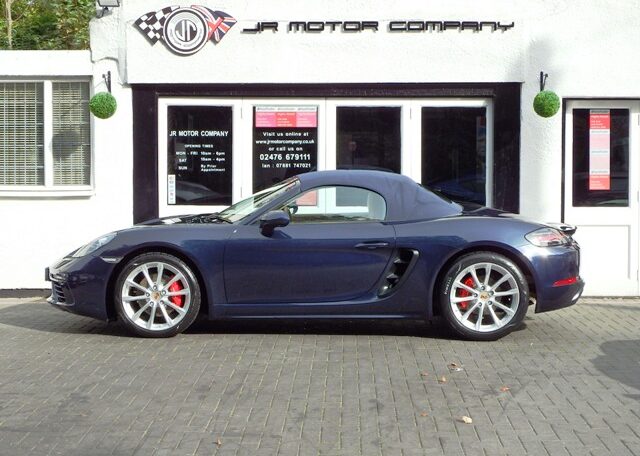


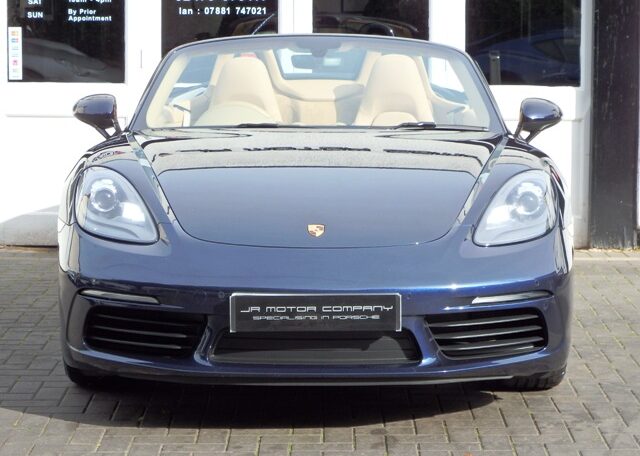

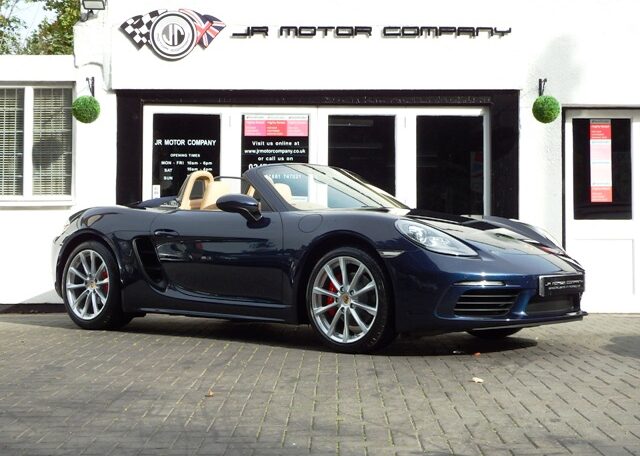



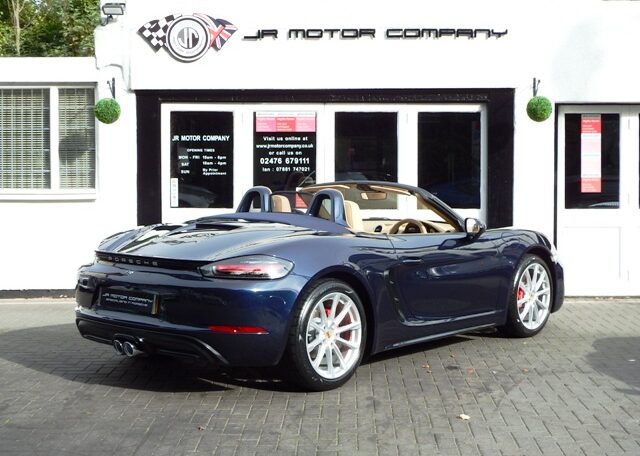





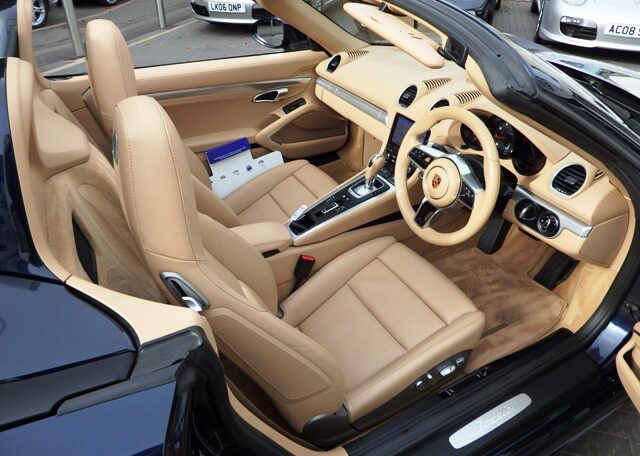





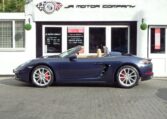












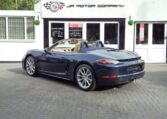


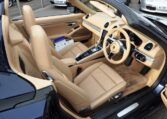



 It’s hard to understate the importance of the Boxster, not just to
It’s hard to understate the importance of the Boxster, not just to 
